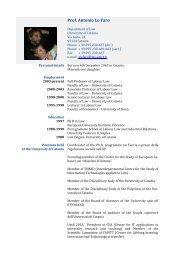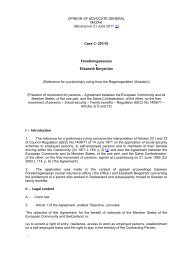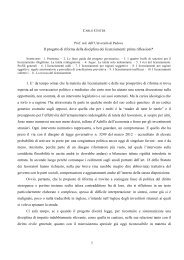Study on non-legislative initiatives for companies to promote gender ...
Study on non-legislative initiatives for companies to promote gender ...
Study on non-legislative initiatives for companies to promote gender ...
You also want an ePaper? Increase the reach of your titles
YUMPU automatically turns print PDFs into web optimized ePapers that Google loves.
Gender equality <strong>initiatives</strong> 107<br />
3.5 Retenti<strong>on</strong><br />
The basic motivati<strong>on</strong> <strong>for</strong> a company <strong>to</strong> engage in retenti<strong>on</strong> <strong>initiatives</strong> is the observati<strong>on</strong><br />
that competences are lost when well qualified pers<strong>on</strong>nel are leaving. Retenti<strong>on</strong> becomes<br />
especially relevant when major changes in the private life of employees make<br />
adaptati<strong>on</strong>s of their work schedule necessary, notably when a child is born.<br />
The large <strong>companies</strong> analysed are in general aware of the range of possibilities that<br />
exist <strong>to</strong> react and keep their female pers<strong>on</strong>nel (as, especially in the first period, birth of<br />
a child leads <strong>to</strong> an interrupti<strong>on</strong> of the work process of women). They have over the past<br />
year elaborated rather sophisticated retenti<strong>on</strong> strategies <strong>for</strong> talented women. These<br />
<strong>initiatives</strong> are often composed of measures from different fields of interventi<strong>on</strong>, e. g.<br />
rec<strong>on</strong>ciliati<strong>on</strong>, career development and networking. The measures range from e. g.<br />
support programmes <strong>for</strong> pers<strong>on</strong>s with caring resp<strong>on</strong>sibilities <strong>to</strong> developing career<br />
objectives or networking. Some company approaches in the field of retenti<strong>on</strong> are<br />
described in the following.<br />
Based <strong>on</strong> the analysis of statistics (that showed a lower share of women in senior<br />
management positi<strong>on</strong>s while the shares of men and women in lower management<br />
positi<strong>on</strong>s were equal) and <strong>on</strong> the percepti<strong>on</strong> that the company is loosing talented<br />
work<strong>for</strong>ce as women tended <strong>to</strong> stay at home after having given birth <strong>to</strong> a child, KPMG<br />
LLP in the United Kingdom has elaborated a comprehensive programme <strong>to</strong> retain and<br />
<strong>promote</strong> women <strong>on</strong> their way <strong>to</strong> senior management positi<strong>on</strong>s. To find out about the<br />
barriers that prevent women from reaching senior level, an <strong>on</strong>-line survey am<strong>on</strong>g all<br />
managers (male and female) has been c<strong>on</strong>ducted.<br />
The 3 most important barriers according <strong>to</strong> this survey lie in balancing work and family,<br />
the percepti<strong>on</strong> of the role of a senior manager, and a lack of respectively <strong>to</strong>o few<br />
female role models. In the next step, a specific training programme that c<strong>on</strong>sists of 3<br />
modules (comprising rec<strong>on</strong>ciliati<strong>on</strong> measures, several training and coaching modules<br />
as well as networking) has been elaborated with the help of internal and external<br />
experts. This programme is c<strong>on</strong>tinuously being m<strong>on</strong>i<strong>to</strong>red and adapted where and<br />
when necessary.<br />
Back in 2005, the then CEO of KPMG in the UK expressed c<strong>on</strong>cern about the dropoff<br />
in representati<strong>on</strong> of women after middle management grade, especially in<br />
client-facing roles. In 2005, women made up approx. half of the UK work<strong>for</strong>ce at manager<br />
level but <strong>on</strong>ly about <strong>on</strong>e third at senior manager level. As research clearly shows<br />
that organisati<strong>on</strong>s which have women in senior positi<strong>on</strong>s are more likely <strong>to</strong> prosper, this<br />
fact did not make good business sense.<br />
Given these circumstances, a decisi<strong>on</strong> was made <strong>to</strong> launch the Retaining Talented<br />
Women strategy. The objective was twofold – <strong>to</strong> understand the reas<strong>on</strong>s behind the<br />
observed drop-out in figures of women <strong>on</strong> the <strong>on</strong>e hand, and <strong>to</strong> take acti<strong>on</strong> in resp<strong>on</strong>se,<br />
<strong>on</strong> the other hand. To ensure high quality of the outcome, the implementati<strong>on</strong> of this<br />
strategy has been based <strong>on</strong> extensive research.<br />
By means of an internal <strong>on</strong>line survey, which was completed by men and women (in<br />
different management levels), the resp<strong>on</strong>dents were asked <strong>to</strong> identify the main barriers<br />
<strong>for</strong> career progressi<strong>on</strong> <strong>for</strong> women. The 3 <strong>to</strong>p barriers that were identified thereby were<br />
balancing of work and family, the percepti<strong>on</strong> of women as less committed due <strong>to</strong> family<br />
commitments as well as a lack of senior or visibly successful role models.
















